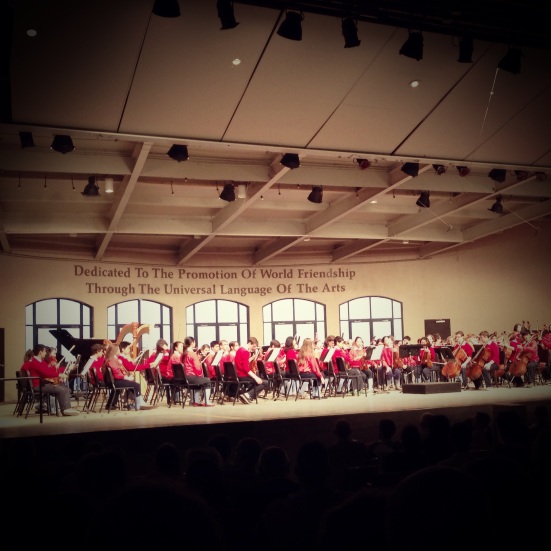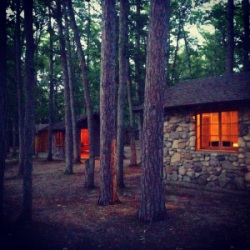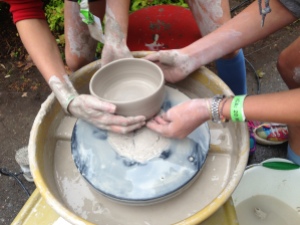It’s a beautiful July night in northern Michigan. I’m settled into an outdoor amphitheater seat next to a comfortable friend, listening to the tuning chatter of a high school orchestra. Windows on the back wall amplify sparkles from the backstage lake. The students quiet, steady their instruments, and begin their musical conversation with the guest conductor. Over the next hour, the symphony selections are as polished as any professional orchestra that my untrained ear has ever heard.
Afterwards, I take the long walk back to my summer housing, passing through compact stone and wood cabins that line the path. In every other cabin, a musician is picking out selections on a piano or running through a violin sequence. At around 9:30, a lone trumpeter plays taps. This might be a signal to the campers to find their sleeping cabins for the night, but the practice sessions in the cabins continue. I’m spending six weeks here, yet I know so little about how this place works. This feels more than a little strange for someone accustomed to being much more intimately involved in structure. I teach, I run in circles, and I finish out my own days long after the last note of taps, tired from many uncertainties but calmed by rhythms that have become familiar.
There is little silence here; it is all filled with music. I’m not here for the music – I’m here to teach visual art. But even in our ceramics studio, we listen to music daily, often live practice sessions from the outdoor stage next door. You can’t walk from one building to another without hearing jazz, classical, solos, and ensembles. Everything I know about music, I learned from my time at the Governor’s School – and everything I know tells me that what I’m hearing is good, really good, far beyond high school level good. Even a potter who quit the clarinet in sixth grade can tell that in these Michigan woods, the rituals and relationships of practice, instruction, and ensembles are producing world-class performers.
It’s been hard to articulate a question that has been troubling me this summer. Whenever I might be close, the jazz and the lake and the sunsets and the campfires lull me out of the tougher work.
Here’s the closest I’ve come. In visual art, what is our symphony?
We’ve got the individual practice down, if not quite enough manpower and hours for it. (The practice cabins don’t seem to require much supervision; on the other hand, studios with chemicals and tools certainly do.) Our students here and my students at home seem to understand – with time and a few failures – that creating good work takes time and persistence. I’m grateful for that. This week, my students were begging for more studio hours. When this starts to happen, I wish I could invite them back to my other studio, where the door is open more often and long days are the norm. I’ve made a niche there for my students, supporting practice and flow. Parts of this summer’s experience have reminded me how good we have it.
But the end result of the artistic effort is an individual creation. It might be briefly part of an exhibition, but each painting, drawing, sculpture, or portfolio remains the property of the individual who created it. We make stuff on our own, exhibit it on our own, pack it into boxes and send it away. So much stuff, in a world already full of clutter. That individual could choose not to show her work, and the empty space on the wall would be filled by another piece.
Conversely, it seems like every chair in the orchestra contributes to a whole that is more than the sum of its practice-hour parts. The second-chair cellist can’t step aside – because without his part, the symphony would not be complete.
What is the something that might connect a visual artist to a bigger whole? What can make an artist believe that her role in community is essential – critical to develop through individual practice, more than recreational, important to a larger piece of the human experience? When we teach technique, we only get a piece of the puzzle – it only goes as far as the individual music lesson. What is the next step that connects us to an ensemble, and makes it harder to leave the stage when the work gets hard?
I probably shouldn’t take that long stroll home tonight. I should walk more quickly back to the studio, finish a few teapots that are on the shelf, mix up a new glaze. But it doesn’t feel like my personal work is part of any symphony. Yet? Right now? There have been times, I suppose, when I’ve felt that sense of connection to a bigger whole. While working on an installation project with my students last year, it felt like each of us was carrying a load that was important and only ours. When Empty Bowls is going well, we are all sharing vital parts of the work.
But not now.
The closest thing that I’ve found to a symphony while teaching high school art has been the times when it feels like I’ve opened connections for my students past the studio walls. The most fulfilling part of teaching is when I’ve reminded them that they are players on a bigger stage than the studio where we get covered in mud. Maybe the community I try to build in a studio – and extend past it – is the best orchestration I’ve done so far? Spending my summer in a forest of music is reminding me that I need to work harder on defining the role that visual art plays in my life, and the role I want it to play in the lives of the people whom I teach.
The musicians seem so grounded. I feel anything but.
At each orchestra concert, after the professional conductor leaves the stage to ovations, a young musician in first chair closes out the evening by conducting as the group plays the summer’s theme. The lights on the stage go down while the lights in the audience come up, and the crowd departs in silence. It’s a ritual, a precious and hopeful one. I will hear variations on tonight’s concert throughout my summer, and every time those lights softly shift as a teenage conductor guides the orchestra home, I am moved to tears.
There doesn’t seem to be any need to hide those red eyes here. It’s another symphony altogether, albeit sometimes a discordant one, to be part of a community of people who are grappling with some of the same questions.










I think we all are that musical symphony. Collectivism vs Individualism. The we are all in this together attitude. For example, you are teaching ceramics to students. The students then become proud of their work. They go home and share their work, thus making other people happy. So your “instrument” of knowledge is being imparted to the great symphony of the world.
As a musician myself, it gives me great happiness to see other people happy by my music, but it also gives me inner-happiness because I know that I am making a small difference in the humongous lives of people.
Our satisfaction from our work should be based on two things. Is it making other people happy? And Is it making me happy? When we learn that other people come first and master the service-oriented mindset, our symphony will come to the climax of the score and we will fade out into a more peaceful and perfect world.
Thanks, Anthony. I think you’re right that it’s important to think about others before self… but I wonder about happiness as the biggest goal. Or – maybe it’s the difference between immediate happiness and the long-term. Making a commitment to daily practice and consistent work isn’t always about happiness. As a teacher, sometimes I feel like half the battle is convincing students that there are other worthwhile goals than immediate gratification. Music and the arts are incredibly honest to this end…